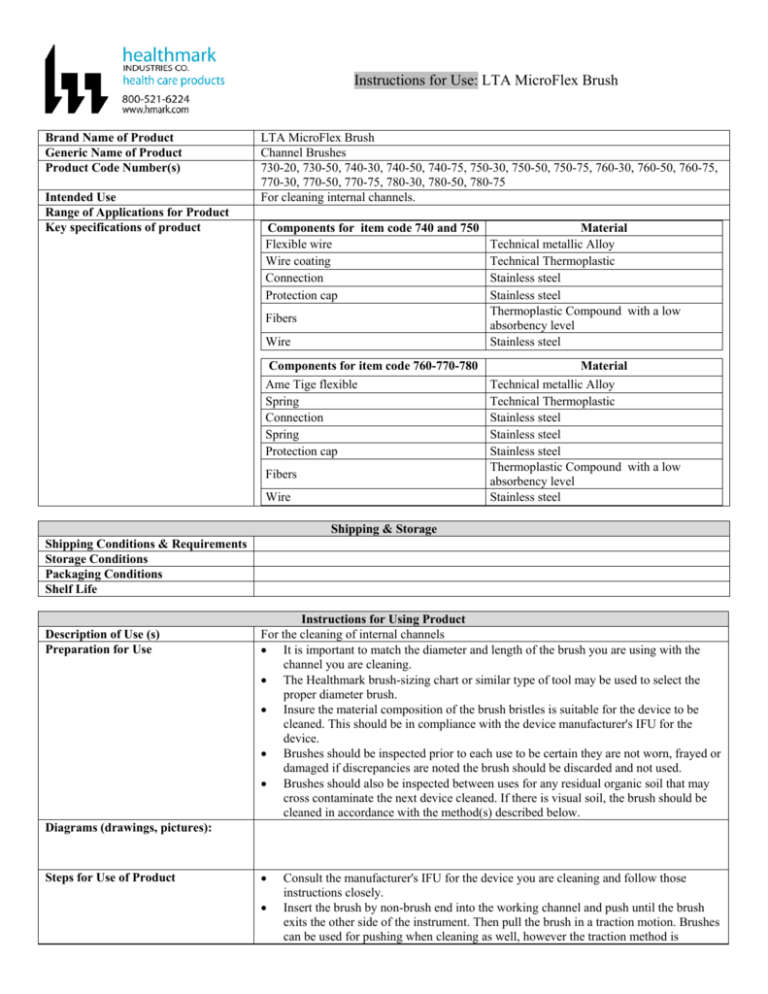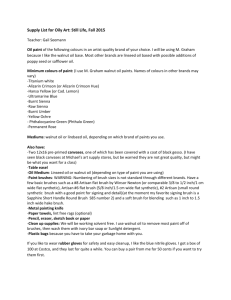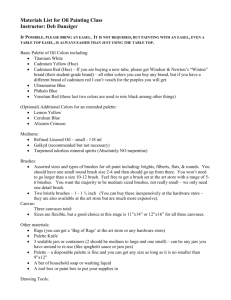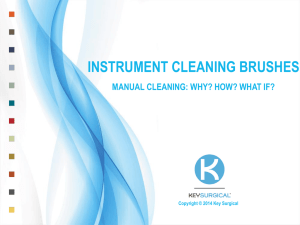LTA Internal Channel Microflex Brushes IFU
advertisement

Instructions for Use: LTA MicroFlex Brush Brand Name of Product Generic Name of Product Product Code Number(s) Intended Use Range of Applications for Product Key specifications of product LTA MicroFlex Brush Channel Brushes 730-20, 730-50, 740-30, 740-50, 740-75, 750-30, 750-50, 750-75, 760-30, 760-50, 760-75, 770-30, 770-50, 770-75, 780-30, 780-50, 780-75 For cleaning internal channels. Components for item code 740 and 750 Flexible wire Wire coating Connection Protection cap Fibers Wire Components for item code 760-770-780 Ame Tige flexible Spring Connection Spring Protection cap Fibers Wire Material Technical metallic Alloy Technical Thermoplastic Stainless steel Stainless steel Thermoplastic Compound with a low absorbency level Stainless steel Material Technical metallic Alloy Technical Thermoplastic Stainless steel Stainless steel Stainless steel Thermoplastic Compound with a low absorbency level Stainless steel Shipping & Storage Shipping Conditions & Requirements Storage Conditions Packaging Conditions Shelf Life Description of Use (s) Preparation for Use Instructions for Using Product For the cleaning of internal channels It is important to match the diameter and length of the brush you are using with the channel you are cleaning. The Healthmark brush-sizing chart or similar type of tool may be used to select the proper diameter brush. Insure the material composition of the brush bristles is suitable for the device to be cleaned. This should be in compliance with the device manufacturer's IFU for the device. Brushes should be inspected prior to each use to be certain they are not worn, frayed or damaged if discrepancies are noted the brush should be discarded and not used. Brushes should also be inspected between uses for any residual organic soil that may cross contaminate the next device cleaned. If there is visual soil, the brush should be cleaned in accordance with the method(s) described below. Diagrams (drawings, pictures): Steps for Use of Product Consult the manufacturer's IFU for the device you are cleaning and follow those instructions closely. Insert the brush by non-brush end into the working channel and push until the brush exits the other side of the instrument. Then pull the brush in a traction motion. Brushes can be used for pushing when cleaning as well, however the traction method is recommended in order to get easy cleaning and avoid retro-contamination of the working channel. Interpretation of Results Contraindications of Test Results Documentation Special Warnings and Cautions Disposal Tube style brushes are intended for use as cleaning tools only. They are not for use in patient care or aseptic techniques. When inserting in channel do not hold brush at compromising angle that would cause it to bend. Not to be used for cleaning plastic and/or fragile materials such as silicone. Always protect yourself from brush splatter and contamination. Clean between each use and disinfect at least daily, preferably between each use in order to limit the chance for cross contamination. See instructions for reprocessing below. Because MicroFlex brushes are used to clean patient used medical devices, it is recommended to dispose of them in the biohazard container with other contaminated devices. Reprocessing Instructions Point of use: Preparation for decontamination: 1. 2. Disassembly Instructions: Cleaning – Manual: Cleaning – Automated: Disinfection: Drying: Maintenance, inspection, and testing: 1. Rinse gross contaminates from the brush in a deep sink and a spray apparatus, such as a shower gun. Use the facilities cold water supply for this rinsing. Brushes may be cleaned manually utilizing a high alkaline instrument detergent or an enzymatic detergent with the suitable enzymes for cleaning the types of soil the brush may come in contact with during cleaning (i.e., protease, lipase, etc.). The IFU for the cleaning agent should be followed closely to insure sufficient exposure time is allowed for the cleaning solution to work. It is recommended that agitation accompany the cleaning process to improve results. Machine cleaning is recommended in a washer disinfector cleared by the FDA. Products should be positioned in the washer to allow maximum water penetration and drainage. No overlapping - partially covered devices will not be washed properly Brushes should be secured in some way, such as the use of a wire or perforated tray that has a wire or perforated lid to prevent brushes from blowing around the wash chamber during cleaning. A container such as the brush cleaning tube from Healthmark is a suitable solution. Products can be cleaned with alkaline, acidic and neutral detergents. For final rinse, DI or RO water is recommended. The standard program to include: 1. Pre-wash with cold water (<100oF) rinse for a minimum of 2 minutes. 2. Washing cycle with alkaline or enzymatic detergent at temperature recommended by the detergent manufacturer for 5 minutes. 3. Washing cycle with neutral pH or neutralizing detergent at temperature recommended by the detergent manufacturer for 5 minutes. 4. Rinse cycle for 2 minutes (preferably with DI or RO water). 5. Thermal disinfection of up to 195oF in compliance with the washer manufacturer recommendations for time and temperature. 6. Drying cycle at temperature not to exceed 240oF. 7. Caution when unloading machine as products will be hot. 8. Visual inspection is required to ensure complete removal of soil. 9. If product still shows soil repeat program. The thermal disinfection stage of an automated washer is sufficient for disinfection of the cleaning brushes. Minimum temperature should be 180oF and not exceed 200oF. Brushes may be disinfected with liquid chemical sterilants in accordance with the disinfection manufactures' IFUs. Be sure to check material compatibility information from the disinfectant manufacturer. Should be compatible with nylon and with stainless steel. Inspect for wear, fraying or damaged bristles or the twisted wire shaft. If observed, the 2. 3. Reassembly Instructions: Packaging: Sterilization: Storage: Additional Information: Related Healthmark Products Other Product Support Documents Reference Documents Customer Service contact: 2015-08-21 Ralph J Basile brush should be discarded in compliance with the disposal instructions described above. Brushes should also be inspected between uses for any residual organic soil that may cross contaminate the next device cleaned. Maximum recommended use life: 3 months 740: maximum number of recommended sterilization cycles is 30 cycles. 750: maximum number of recommended sterilization cycles is 60 cycles. If steam sterilizing, use standard FDA cleared cycles: 270F/4 minutes or 275F/3 minutes. Avoid compression during sterilization and storage Follow all manufacturers’ directions for proper usage and disposal of all cleaning agents and chemical disinfectants agents. Brush Cleaning Tools Prosys Brochure, Prosys Pricelist Healthmark Industries Company, Inc 33671 Doreka Fraser, MI 48026 1-586-774-7600 healthmark@hmark.com hmark.com









